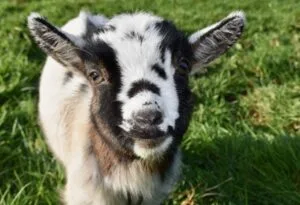No products in the cart.
Goat
Baby Goat Poop Chart: Keep This Chart Handy To React In Time
Raising animals is similar to raising babies as it is almost impossible to communicate verbally with them and therefore it is challenging to know whether they are doing well.
However, just like human babies, a goat’s poop can actually tell you quite a bit about their health.
By understanding and applying the baby goat poop chart below, we hope to help you prevent medical expenses as early detection is better than seeing the problem too late.
*This post may have affiliate links, which means I may receive commissions if you choose to purchase through links I provide (at no extra cost to you). As an Amazon Associate I earn from qualifying purchases. Please read my disclaimer for additional details.
Baby Goat Poop Chart
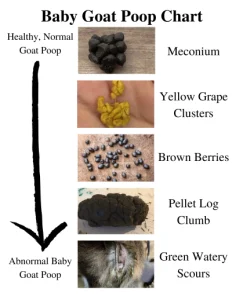
There are a lot of changes in baby goats’ poop during the first weeks after birth.
Healthy goats have loose pellets that do not clump whereas goats whose poops are sticky, smooth, or runny may indicate there is something wrong.
Hence, it is important to keep your eyes on it to detect any potential problems, then treat them properly.
Normal Baby Goat Poop
Meconium
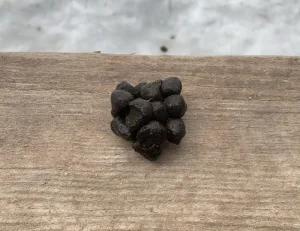
Meconium is the first stool after birth that your newborn baby goat will have in the first 0 to 48 hours post-birth and is considered absolutely common and normal.
This type of poop is very dark, almost black, and thick like tar. This sticky poop come without a smell.
Yellow Pudding Poop
Yellow pudding poop occurs between 1 and 14 days old and is also a normal poop that shows your baby goat is fine and healthy.
These poops look like yellow and thick pellet logs because their diet includes only pure milk and is similar to yellow grape clusters but in a pudding consistency.
Remember to sanitize the anal area of dried poop as this poop might clog up the works. Just like meconium, it is very sticky but smells like soured milk.
Read More: How Often Do Canada Geese Poop? It’s more than you probably think!
Yellow, Grape Clusters
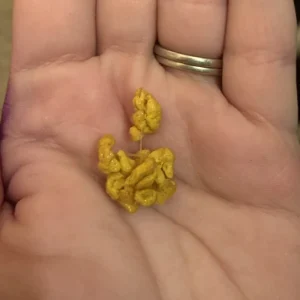
If your baby goats are about 10 to 20 days old, they will have yellow, grape cluster poops.
Do not freak out because this poop is also normal.
Due to the development of the digestive system, goat poop now will change from pudding poops into yellow berries.
As your baby goat starts to consume grain and hay, the color will also turn brownish.
Brown Berries
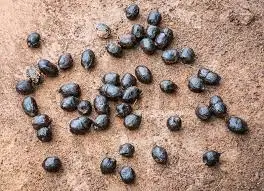
You will see brown berry goat droppings when your baby goats turn 2 to 4 weeks of age or older.
This poop looks like oval-shaped pellets and is normal, so you should not worry.
Miniature brown berries are a signal to tell you that your babies are at the end of the baby goat pooping stage as this poop is normal for adult goats.
Read more: Best Goat Milking Machines on the Market
Abnormal Baby Goat Poop
Yellow, Watery Scours
If your baby goats experience yellow, watery scours between 1 and 14 days old, they are signaling that they are in trouble.
This is a symptom of watery diarrhea, caused by extra-rich milk, or too much milk per feeding or milk replacer.
A consequence of yellow, watery scours is that your goats will dehydrate quickly.
A way to treat this is to prevent oversupply by reducing the amount of milk per feeding until the scours cease, or providing another alternative to a milk replacer.
It is also advised to employ milk replacers made specifically for goats, rather than those for all stock or cows. The good news is that no medication is required.
But, if the situation persists, consult a vet immediately.
Profuse Bright Yellow Or Green Watery Scours
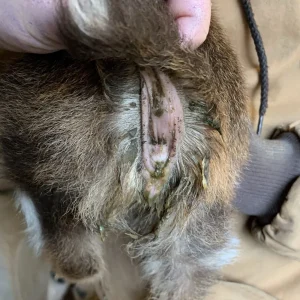
Profuse bright yellow scours or green watery scours usually arrive after the green diarrhea of coccidiosis but can come independently.
The fact that the scours are super watery, smelly, greenish, or brownish might indicate your goats’ digestive system has been heavily damaged heavily.
If the scours contain blood, the tentative diagnosis now is enterotoxemia, caused by a bacterium called Clostridium Perfingens.
This bacterium is found in the soil and is not able to damage a healthy digestive system. Instead, it often attacks unhealthy goats formerly suffering from coccidiosis or bloat.
The bad news is your goats are in mortal danger and your goat needs medical attention.
In this case, oral large doses of CD Antitoxin help profoundly as they will neutralize the toxins produced by the bacteria.
Your goat will need to take 10 – 20 cc orally every 4 hours until your goats are better or follow the detailed procedure in this Sheep & Goat Medicine book.
A better way is to vaccinate your pregnant goats with CDT toxoid at 4 weeks before their labor and vaccinate your goats at 4 weeks to strengthen their immune system to avoid the disease.
Smelly, Green Diarrhea
Smelly, green diarrhea can happen at 21 – 30 days old.
When seeing foul-smelling scours, 90% of your goats are going through a coccidiosis infection caused by a tiny single-celled internal parasite that lives in the wall of your goat’s intestine.
This infection is not easily destroyed by deworming pills.
This should be treated instantly and strongly with a prescription for sulfa-based antibiotics, which can remove coccidia parasites, including Sulmet, Di-Methox, or Corid.
Coccidiosis infection is more dangerous than it might seem and can cause death or kids being stunted for life as the result of damage to the intestinal lining.
Still, prevention is better than reacting.
At sharply 21 days old, your goats should be given a sulfa-based antibiotic as the parasites’ life cycle takes 21 days. Wiping them out before they are fully developed is utterly important.
No Poop
Though you will mostly see a lack of poop at 1 to 14 days old, it can happen anytime.
Many goats experience this, yet, if your baby goat is not pooping, it is actually the start of a real issue.
There are three possible causes:
- They might be born without any anus
- or they are not eating enough or getting good water.
- or the first sticky poops cause the blockage, hence how goats can suffer constipation.
Keep in mind that constipation is one of the major causes of “mysterious deaths” in young kids.
Just like other diseases, this should be treated in a timely manner as toxicity will be created by the unpassed stool in the kid’s system.
To treat, mix 1 oz warm water and 1 tsp mineral oil or a drop or two of soap.
Then fill a large syringe without a needle or a nasal bulb with a warm water enema. Insert the syringe into the anus and slowly push the plunger.
Your goats should be able to poop within the next 15 minutes.
Consider repeating the process if the symptom continues and giving them a shot of CD Antitoxin (not the toxoid) or a good dose of Milk of Magnesia.
Read more:List of 7 Best Fence for Goats
FAQs About Baby Goat Poop
1. How much should a baby goat poop?
A baby goat should poop at least once a day, otherwise, there might be problems.
First, the goat might be born with no anus. Second, it does not get enough water or milk. Third, it is suffering a symptom of constipation.
2. How often should a baby goat poop?
Healthy baby goats might poop a lot in the first few days. Then, they poop once a day or every time after eating.
3. What color is newborn goat poop?
The first newborn goat poop, also known as meconium, has a dark color which is almost black. It is thick, sticky, and often gives no smell. Usually, you will see it within 48 hours after the goat is born.
4. What should baby goat poop look like?
In short, from 0 to 48 hours after birth, the poop is sticky and dark (often black) with no smell. In the next 2 weeks, it turns yellow, thickly pelleted, and smells like soured milk.
From then on, the goat poop is brown berries.
5. Can too much grain cause diarrhea in goats?
Too much grain, too much milk, and too much grass can cause diarrhea in goats because the bacteria in a goat’s digestive system can become overloaded.
6. How often do you give goats probiotics?
While giving goats probiotics is not mandatory, you can give goats probiotics 3 days after birth as well as to adult goats when they are sick, being transported, or stressed.
Probiotics help keep their digestive systems working properly, so they are not required when a goat is healthy.
7. At what age do baby goats start drinking water?
Baby goats start drinking water fairly soon after birth. For the first one to two months of their life, they only drink water and some water.
Once they start eating grass and hay, they will need two to three gallons of water per day.
8. How do you rehydrate a goat?
To rehydrate a goat, mix electrolyte powder with water once you sequester the goat from the general population, offering this mix up to three times per day for up to three days.
If they still have persistent diarrhea or are not getting any better, you will need to visit your veterinarian.
Electrolytes restore nutrients that have been lost and can be found in glucose, probiotics, prebiotics, and glycine.
9. What causes scours in goats?
Many different types of stressors can result in scours in goats.
These stressors include cold, wet weather, exposure to new animals, vaccinations, weaning, unsanitary conditions, and sudden changes in diet or living conditions.
Conclusion
As you know, a goat’s digestive system is sensitive and can be easily upset.
Hence, be mindful, or else instead of raising a happy and healthy herd of goats, you might end up scratching your head over dealing with goat scours all the time.
My advice is to take notes of changes in their poop to prevent unexpected problems. You might also want to keep this baby goat poop chart to react in time.
